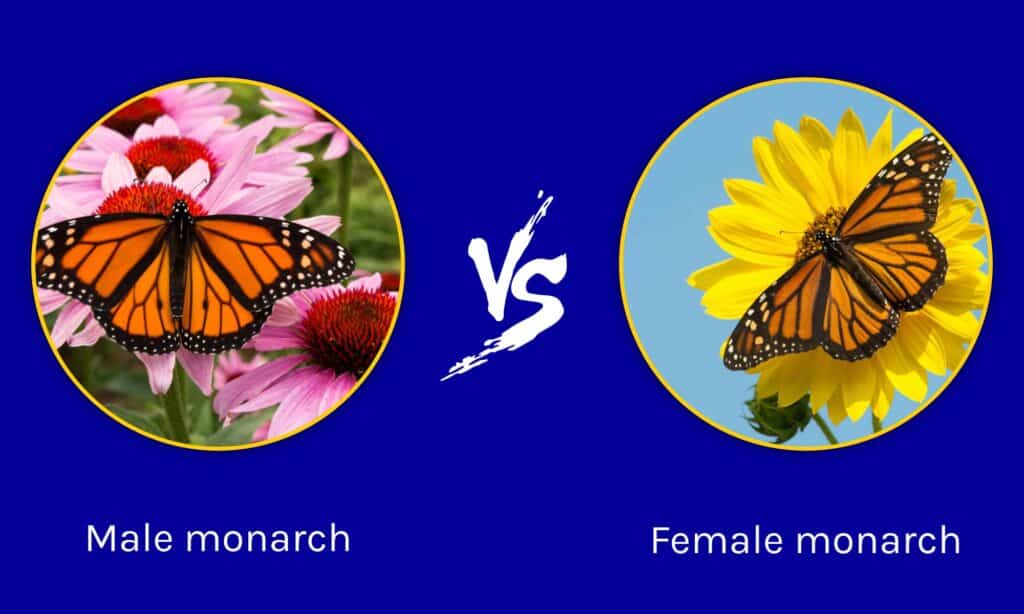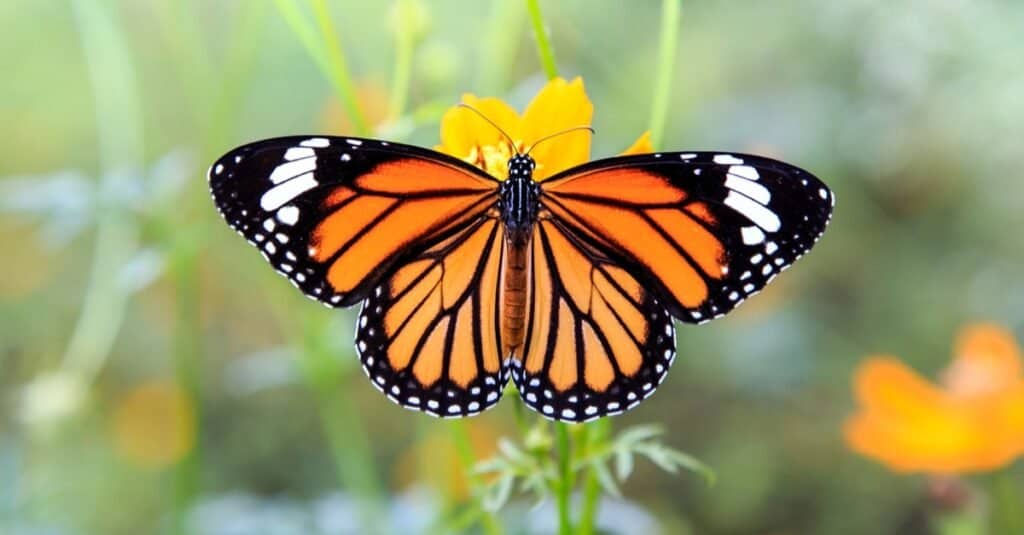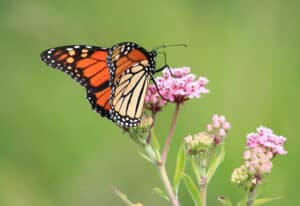The monarch butterfly is a beautiful insect known for its bright orange color. It has distinct lines of black, and white spots on the edges of its wings. So, the chances of identifying one on sight are pretty good. But can you tell a male monarch from a female monarch at a glance?
This article will explain the differences between male monarchs and female monarchs. Some are notable features that can be identified at a glance, while others are behavioral and lifestyle differences that exist between them. Here is the ultimate male vs female monarch description.
Comparing a Male Monarch and a Female Monarch

| Male Monarch | Female Monarch | |
|---|---|---|
| Size | Weight – 0.001 to 0.0013 lbs Wing Length – 2.03 to 2.06 inches Wingspan – 3.5 to 4.1 inches | Weight – 0.0009 to 0.0012 lbs Wing Length – 1.9 to 2.05 inches Wingspan – 3.5 to 4 inches |
| Morphology | – Larger flight muscles. – Larger and heavier wings. – Slight bulge on the sides of the stomach. – Most chemoreceptors are located on the antennae and are used for food. | – Smaller flight muscles. – Thick but light-weighted wings. – No slight bulge on the sides of the stomach. – Females have a large concentration of chemoreceptors on their legs to locate host plants for eggs. – The chrysalis has a small line across one of its abdominal segments. |
| Courtship Behavior | They draw down flying females to attempt mating. | Females may initiate mating by releasing pheromones to attract males. |
| Males may travel in search of females. Males often remain in the same area for longer periods. | Females travel in search of milkweed to lay eggs. Females move frequently, usually in search of milkweed. |
The Key Differences Between a Male Monarch and a Female Monarch
The most visible differences between male and female monarchs are in their morphology and behavior. Although male monarchs tend to be bigger than females, you may be unable to identify the sex of any butterfly unless it is in the company of others.
Male monarchs have distinct blotting on their hindwing. The blotting is usually on the vein lines of the hindwing or the top surface of its edges. These blots are not present in females. On the other hand, females have thicker wing veins.
Another key difference is the tendency to remain in the same location. Males stay longer in the same area, often patrolling for females, while females move around in search of suitable host plants.
Below, we’ll discuss the differences between the male and female monarch butterflies in detail.
Male vs Female Monarch: Size

Male monarch butterflies have longer wings than females.
©CHAINFOTO24/Shutterstock.com
Monarch butterflies are characteristically light creatures. Thus, the difference between the weight of adult males and females varies slightly. However, males are known to have longer wings and larger overall body weight.
The average weight of males falls between 0.001 to 0.0013 pounds, while the weight for females is around 0.0009 to 0.0012 pounds. Females have light-weighted wings, compared to males. So, this contributes to the difference in their overall body size.
The average length of male monarch wings is 2.03 to 2.06 inches, while female wings are about 1.9 to 2.05 inches long. The wingspan for both sexes ranges from 3.5 inches to 4.1 inches. Again, the difference in size is not easily decipherable at a few glances. So, you may be unable to differentiate them by size unless they are gathered in the same enclosure or area.
It is worthy of note that migrating monarchs are known to have longer wings than others who have not begun migration. So, if you compared the wingspan of a female migrating monarch with a male who hasn’t, there are chances that the females’ would be longer. The bigger the wings, the heavier a monarch butterfly will weigh.
Male vs Female Monarch: Morphology

Female monarchs have thicker wings which make them stronger and able to fly much better than males do.
©Cathy Keifer/Shutterstock.com
Both butterflies look quite similar, but if you get a close look, there are clear differences. First, female monarchs have thicker wings which make them stronger and able to fly much better than males do. In reality, females have to make several trips in search of host plants for laying eggs. So, you might say they need the extra sturdiness.
Another morphological difference is the presence and use of chemoreceptors. Most chemoreceptors for the male monarch are concentrated on its antennae, which it uses to locate food. Females, on the other hand, have large amounts of their chemoreceptors on their legs. It is used to test milkweed and determine whether it is suitable for laying eggs.
Male vs Female Monarch: Courtship Behavior
Unlike queen butterflies, male monarchs do not seduce the females. Their style is more of a “take-down” strategy. Typically, the male will grab the female in flight and wrestle with her in an attempt to mate. The females are known to release pheromones in the air to attract males when they wish to mate. The males aren’t known to be picky, however, a female may or may not submit to the advances of the male. Even if she does, such a butterfly will then determine if the sperm is suitable to fertilize her eggs. If she doesn’t find them fit, she keeps the spermatophore as a supply of nutrients (nitrogen) for herself.
Male vs Female Monarch: Habitat
In general, monarch butterflies can live anywhere, except in deserts. While males can remain in the same area for long periods, females move frequently. When a male moves, it is usually in search of a female to mate with, or for migration. Females, on the other hand, move around fields, testing milkweed to find suitable places to lay eggs. This means that they can travel over long distances, testing plants with their chemoreceptors until all their eggs have been laid. This process is important because of the larvae. Eggs hatch into larvae (caterpillars) and larvae feed on milkweed, without which they will not survive.
The photo featured at the top of this post is © rck_953/Shutterstock.com
Thank you for reading! Have some feedback for us? Contact the AZ Animals editorial team.






